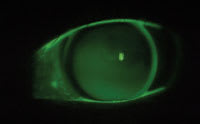prescribing for presbyopia
From
GPs to GP Multifocals — A Natural Progression
BY
MARY JO STIEGEMEIER, OD, FAAO
Resbyopic patients are often perfect candidates for GP multifocal lenses. For many patients these lenses offer an opportunity to have uncompromised distance and near acuity. GP multifocallenses are avcals are available in two general categories: Simultaneous and translating or alternating. Simultaneous lenses present distance and near optics at the same time. You can control the proportion of distance and near optics to some extent, and these lenses translate slightly upward in downgaze, improving near performance. Alternating designs can fit "on alignment" and are designed to have one optic in front of the pupil at a given time. During downgaze the lens must translate superiorly so the pupil can access the near segment. Alternating designs are available in a wide parameter range with high adds.
Progressing Through the Years
Current GP lens wearers are excellent candidates for GP multifocal contact lenses. You can "age enhance" these lenses to help your patients transition through emerging presbyopia to mature presbyopia. Take the following case, for example.
Patient LD, presently age 62, was an adapted GP contact lens wearer when she became presbyopic, making her a great candidate for the transition into GP multifocals.
In 1985 at age 42, she successfully wore Polycon lenses with a prescription of OD 7.40 9.5 –5.75 20/20 distance and near, OS 7.50 9.5 –4.75 20/20 distance and near. Her manifest refraction was OD –6.25 –0.75 x 085 20/20 no add, OS –5.25 –0.75 x 095 20/20 no add, and she had keratometry readings of OD 45.50/46.00, OS 45.00/45.50.
|
|
|
|
|
Figure 1. Fluorescein pattern of LD's translating GP design. |
In
1990 at age 47 we successfully refit her into VFL II simultaneous vision lenses
(Conforma Contact Lens) manufactured in Fluoroperm 30 (Paragon Vision Sciences)
in the following parameters: OD 7.20 9.5 –8.25 20/25 +2 Jaeger 1, OS 7.10
9.5 –8.00 20/25 Jaeger 1. Her manifest refraction was OD –6.00 –1.00
x 075 20/20 +1.75 add Jaeger 1, OS –5.50 –1.50 x 105 20/20 +1.75 add
Jaeger 1, and she had Ks of OD 45.00/46.00, OS 45.00/
46.25.
LD wore this simultaneous vision lens design for nine years, until her add progressed to full +2.50D. She complained of slightly blurred distance acuity, but good near acuity; when we improved distance acuity, we couldn't achieve adequate near acuity.
In 1999 we switched LD into a GP translating design originally in Boston ES, now in Boston EO (Bausch & Lomb) material in the following prescription: OD 7.50 –5.50 9.5/9.2 4.5 segment height 1.5 prism +2.50 add 20/20 distance and near, OS 7.50 –4.75 9.5/9.2 4.5 seg. ht. 1.5 prism +2.50 add 20/20 distance and near (Figure 1). Her manifest refraction was OD –6.00 –1.00 x 075 20/20 +2.75 add Jaeger 1, OS –5.25 –1.25 x 105 20/20 +2.75D add Jaeger 1. Her Ks and topography were OD 45.25/46.00, OS 45.00/46.00, clear mires.
Best Vision for Presbyopes
Both simultaneous multifocal GP designs and translating GP designs can provide excellent visual capabilities and healthy physiology. Today's high-Dk contact lens materials and improved designs will ensure visual and physiological success.
Dr. Stiegemeier is in private practice in Beachwood, Ohio. She lectures throughout the country on the subject of contact lenses and performs clinical research.




